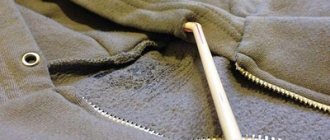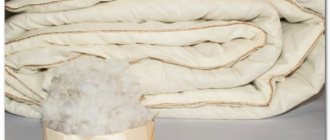Features of the material
In combination with other materials, polyester significantly increases the quality of the final product.
Polyester is a synthetic fabric made from polyester fibers used in sewing clothes, clothes and wardrobe items. Unlike most natural fabrics, this is a more accessible and cheaper material that has a whole range of positive qualities.
For example, a combination of cotton and polyester gives the final product increased practicality and increases the service life of the product. The fabric becomes durable, wear-resistant, wrinkles and gets dirty less, does not stretch and allows air to pass through well.
Polyester production
Production of polyesters and polyester
In their pure form, polyester fibers are made from products of the oil and gas industry. This happens as follows:
- Isolation of components necessary for the production of polystyrene (raw material for future fibers).
- Obtaining molten polyester.
- Filtration and purification of polyesters.
- Manufacturing and production of polyester fibers
- Finishing threads for 100% readiness
- Fabric release
To improve polyester, chemists create combinations of polyester with various natural, artificial and synthetic fibers. As a result, a wide variety of fabrics appear that are not inferior in quality and appearance to natural materials.
The quality of the fabric directly depends on the cleanliness of the technological process. Well-made polyester has no odor, such material does not leave marks on the body and does not fade. Clothes made from high-quality polyester can be used with pleasure in any area of our lives.
Indicative characteristics of polyesters
100% polyester can have completely different appearance and properties. This all depends on the chemical composition of the raw material, the shape of the fiber and the type of weave. It often looks like wool and feels like cotton.
Advantages of polyesters:
- Increased resistance to bad weather conditions (cold, wind, sun, rain and snow). Clothes made from polyester are always warm and dry.
- Wear resistance. High resistance of polyester fiber to physical stress.
- Easy to care for. Polyester washes well, dries quickly, and does not wrinkle.
- Resistant to fading and fading.
- Easy.
- Inexpensive, has an affordable price.
- Not susceptible to damage by fungus or moths.
- Has dirt-repellent properties.
- It holds its shape well and tends to remember it when heated.
- Polyester does not absorb odor.
Cons of polyester:
- Increased density. What makes this clothing uncomfortable in hot weather.
- Unresistant to aggressive chemical compounds.
- Low quality polyester fibers may be allergenic.
- Polyester fabric does not dye well
What is polyester?
Polyester is a synthetic fiber created by chemical synthesis from alcohol, gas, coal, oil and acids.
It has been used in the textile industry for almost 80 years. For sewing products, both 100% polyester and in combination with other fibers are used.
Polyester fiber is often combined with other fibers:
- polyamide, mainly for sewing underwear;
- spandex, for making stockings, socks, tights;
- cotton, wool to increase the naturalness of the fiber;
- viscose for better moisture absorption.
Despite the fact that polyester is a synthetic fiber, it occupies one of the leading positions in the textile production market. Sew from fabric:
- casual, special and outerwear;
- branded outfits;
- bedspreads and rugs;
- blankets;
- drapes and curtains;
- upholstery for furniture.
The fiber is used as a filler for pillows, blankets, jackets, and coats.
Drying and ironing
Caring for polyester is not limited to washing. The item must be ironed properly. Do this when the fabric is slightly damp. It is recommended to use an iron, ironing mode – “Silk”. But there is no need to dry the product in the machine. PE dries quickly on its own, unless it is clothing with filling. But in this case, machine drying is not used. It is advisable to dry the product in the fresh air, and to speed up the process, you can use a hairdryer. It is turned on to the minimum temperature and kept at a distance of 20 - 25 cm.
Dear readers of the Tkan.Club website, if you still have questions on this topic, we will be happy to answer them. Leave your reviews, comments, share stories of how you washed PE items! Your life experience may be useful to other readers.
How to wash cotton so it shrinks
Cotton products with high quality material do not change their shape and size in 95 percent of cases. But if this happens, the culprit may be incorrect washing temperature, careless spinning, or prolonged wear. To make the sweater fit, you need to perform a few simple steps.
- Before washing, you must read the information on the tag or label. The manufacturer gives recommendations on temperature and spin conditions. In order to achieve shrinkage of your favorite outfit, you need to exceed the proposed indicators. At the recommended temperature of 40 degrees, you need to set the machine to 60. The spin mode also requires an increase. This method can be used with white and dark jumpers. Colored ones may lose their brightness and look washed out.
- After washing in the machine, you need to take the item out and place it in a pre-prepared solution. For seven liters of boiling water you need to pour one cap of conditioner. The basin with the sweater is covered with cellophane for seven minutes. During this time he loses one size. To make the jacket even smaller, you need to extend the exposure time by 15 minutes.
- To make it shrink another half size, you need to use a dryer. If it is not there, then the item is laid out on the table, excess moisture is removed with a cotton towel, and hung in the sun.
The appearance of clothing depends on how you wash and dry it. If everything is done correctly, the jumper can lose from one to three sizes. In this case, the deformation will disappear and it will return to its original appearance. Colored items require gentle washing to avoid losing the brightness of the tone.
If you don’t have a washing machine, you can carry out all the manipulations manually. It is necessary to use very hot water and not allow the item to drain, so as not to stretch it lengthwise.
RESULTS
олиÑÑÑÐµÑ â ÑÑо одна из Ð½ÐµÐ¼Ð½Ð¾Ð³Ð¸Ñ Ð¼Ð°ÑеÑий, к оÑоÑÐ°Ñ Ð½Ðµ ÑминаеÑÑÑ Ð¸ не ÑÑебÑÐµÑ Ð³Ð»Ð°Ð¶ÐºÐ¸. RESULTS ´Ðµ вÑе-Ñаки обÑазÑÑÑÑÑ Ð·Ð°Ð» › ладиÑÑ Ð¿Ð¾Ð»Ð¸ÑÑÑÐµÑ ÑÑÑгом?».
RESULTS ROOM RESULTS ¼Ð¿µÑаÑÑÑÑ. RESULTS ¿Ð¾ÑколÑÐºÑ ÑмеÑовÑе Ñкани, в ÑоÑÑа ROOM волокна, гладиÑÑ ÑледÑÐµÑ Ð¿Ð¾-ÑазномÑ.
ROOM, ROOM, ROOM ´Ð°Ð²Ð»ÐµÐ½Ð¸Ð¸ ÑÑÑга RESULTS. RESULTS ¾ пеÑед ROCK ´Ð¸ÑÑ Ð¿Ð¾Ð»Ð¸ÑÑÑеÑ, его нÑжно подложиÑÑ Ð¿Ð¾Ð´ вР"Response" RESULTS CONTENTS.
" RESULTS » » » » ÑÑ Ð¼Ð¸Ð½Ð¸Ð¼Ð°Ð»Ñной пÑи ÑÑÑановленном ÑежР¸Ð¼Ðµ “ШеДк”. RESULTS Ñми ÑканÑми".Â
Wash by hand - safe
Yes, washing a parka or other item is troublesome and takes a lot of time. But the stains will be washed off, and the clothes will not lose their decent appearance. This is especially true for polyester coats (from experience), jackets and down jackets.
Instructions for hand washing polyester fabrics:
- Fill a basin with warm water - 30–40 ºC, no more.
- Add and thoroughly dissolve the detergent in the water.
- If the item is very dirty, soak it in this water for half an hour to an hour.
- If there are old, stubborn stains, rub them with laundry soap.
- After the time has passed, add hot water to the basin after removing the item.
- Press the item in a circular motion in the water, without rubbing the fabric too much with your hands.
- Rinse in cool water.
- Lightly wring out the washed item, do not twist or pull it.
- Hang it on a hanger right above the bathtub and let the water run away on its own.
- Then move it where it is convenient for you, but away from heating appliances. Do not remove from hangers to avoid deformation of the fabric.
To speed up drying, take a terry towel and wrap the washed polyester item in it. The towel will absorb most of the moisture. A terry towel will speed up drying; wrap the washed item in it for 7-10 minutes. Photo: home-gid.com
How to make something made of wool shrink?
When restoring woolen items, you need to read the instructions for washing them and do the opposite. You just need to act carefully, without going to extremes.
To minimize the risk of product damage, it is recommended to work according to the following scheme:
- First, soak the affected sweater or hat in hot water. The duration of the stage should not be more than half an hour. The fluid temperature is set approximately 20 degrees higher than what is indicated on the label.
- After the specified time, rinse the woolen item using very cold water, you can even add a few pieces of ice to the liquid. A properly organized temperature difference can do a significant part of the work.
- Wrap the washed wool in a dry and warm terry towel. Remove excess moisture with blotting movements. Twisting woolen items is highly discouraged, especially a sweater, dress or jacket.
- Next, the clothes are dried. We lay hygroscopic fabric on a dense horizontal surface without visible relief. Lay a sweater or other item on top. It is advisable to direct flows of artificial heat onto the wool, then the shrinkage will be more dense. During drying, you need to give the item the desired shape with your hands, regularly adjusting the material so that it does not stretch.
Tip: It is better to pull a woolen hat onto an inverted salad bowl or vase with a rounded smooth bottom of a suitable size.
Washing in a machine also causes strong shrinkage, but it is very difficult to control the process. As a last resort, a stretched sweater can be washed in a special mode for wool or hand washed, but the result can be unpredictable.
Drying such things
Manufacturers indicate certain icons on labels to indicate the drying mode of such material:
- Three vertical stripes in a square. In order to regulate the flow of water from the product, it is recommended to dry it in a suspended state. It is best to do this above the bathtub, hanging the product on a hanger.
- A rectangle with a circle inside and a dot in it. This means that polyester can be washed at a temperature of no more than 60 degrees and on a delicate cycle. Dry flat.
- A circle inscribed in a square crossed diagonally. You cannot use multifunctional washing machines to dry such fabric. This procedure can only be carried out at ambient temperatures up to 40 degrees. Natural air circulation is also very important.
Polyester products can also be washed by hand. Dissolve the required amount of powder in a bowl of warm water and lower the item into it. If the contamination is severe, soaking should last at least an hour. Due to the special structure of artificial fibers, clothes made from these synthetics need to be rinsed very well. Otherwise, streaks may remain on it. Do not squeeze the product, but roll it up and press to drain excess water. Dry on a hanger over the bathtub.
Correct ironing
Such items should be ironed following the following rules:
- If the fabric contains mixed natural and synthetic fibers, it does not need to be ironed.
- The exception is when the fabric gets jammed in the drum of the machine.
- Irregularities are smoothed out with an iron that has been preheated to 100 degrees. The maximum temperature is 110 degrees.
- In order not to spoil the item, you can place gauze, folded in half, between the sole of the device and the fabric. You can replace it with a cotton cloth.
What to do with knitted items
Hand-knitted items require delicate care. If the knitting has stretched over time, this problem can be eliminated.
Temperature difference
In order for a knitted item to return to its previous size, you need to soak the item in boiling water for 10 minutes. After this, the knitted product is placed in a cold place and left for 10 minutes, after which it is rinsed in warm water. This effect will reduce the density of the fibers.
Steaming with an iron
Using an iron, you can reduce a wool item by one size. To do this, the product is laid out on an ironing board, sprayed with water and, using steam, thoroughly ironed.
How to reduce width, not length
Very often knitted items stretch in width. In order to resolve this problem, you must perform the following procedure:
- After washing, spread the wet item on a towel to dry;
- using pins, give the product the required width and pin it to the towel;
- Correct the width every 30 minutes; the procedure is carried out until the product is completely dry.
Using this method will correct the width of the product by one size.
Correction of individual elongated sections
A very common problem that wool owners may encounter is stretched parts such as elbows or knees. To fix this problem you need to:
- spread the product on the ironing board;
- pour water into a spray bottle and spray the desired area;
- iron until completely dry.
The same result can be achieved using an iron with steam function.
How to restore stretched sleeves
In order to fix stretched sleeves on a sweater, you need to perform the following algorithm of actions. In order to return the shape to the sleeves, you need to:
- boil water in a basin;
- lower the sleeves one by one into boiling water for 5 minutes;
- Lay the sweater on a towel and leave until completely cool.
The effect of this procedure lasts for several weeks, after which the procedure must be repeated.
If the product is combined from different materials
If the product that has been stretched consists of different types of fabric, it is necessary to evaluate the components. If it is necessary to change the size, a technique is used during which the item is soaked in hot water and left for some time. If individual parts need to be restored, only part of the product is soaked in hot water so as not to harm other fibers.
Using simple techniques will quickly return your favorite things to the required shape. The effect of hot water on some types of fabric allows you to quickly return to the desired shape without harm to the fabric fibers. However, before carrying out this procedure, it is necessary to study the marks on the tags.
How to properly wash polyester in a washing machine
Let's start talking about washing with outerwear. Heavily soiled items and items with stubborn stains made from polyester should be washed in a washing machine. This is the only way you can return the products to their original condition. You can wash things made of polyester, for example, a coat made of mixed fabric, in the machine by setting the “delicate wash” or “gentle wash” program. Otherwise the coat may shrink. You need to choose a special detergent for washing wool products. Set spin to 400 rpm. Let the water drain and hang on a hanger.
Before washing a polyester coat, it is advisable to turn the garment inside out. Polyester blend in knit form can be easily stretched
Please note: if the product has buttons, buckles, or zippers that can lead to the formation of such, it is better not to risk it and turn the item inside out.
It is also worth paying attention to other co-washable items containing similar accessories. Before washing a polyester jacket in a machine, it should also be turned with the lining facing out.
When washing, use the “gentle wash” mode, at a speed of no more than 400 rpm. Use an air conditioner to remove static electricity.
Basic rules for machine washing
Can polyester be machine washed? Of course, if you follow a few rules:
- The product tag indicates that machine washable.
- You cannot wash polyester items with wool or cotton items, otherwise pilling cannot be avoided.
- When washing polyester, use only warm water; many experts agree that this is a more effective method. Medium temperature water is most optimal for this type of fabric. Cold water will not be able to remove greasy stains; hot water deteriorates the structure of polyester, the item wrinkles greatly and loses its original appearance.
- You should opt for classic washing powders or washing gels. Possible option: powder “Losk”, “Persil”, “Tide”, and so on. The main thing is that they have the inscription “color” on them. During the washing process they will be less aggressive. In this regard, most existing detergents are suitable for polyester. You should try to avoid formulas for items with hard-to-reach stains. They can affect the color and quality of the fabric being washed.
- Using an air conditioner will relieve the product from the electrification effect. Without it, polyester is prone to this problem. An electrifying effect occurs when polyester knitwear is washed, for example with white towels. As a result, their small white particles will stick to the knitwear.
- White polyester clothing can be soaked overnight in a solution containing four liters of warm water and half a cap of dishwasher detergent. This will greatly help whiten items before the main wash. If your clothes are colored and heavily soiled, you can use light bleach. Never use bleach to bleach white polyester.
- Many experts recommend using a specific program to make ironing easier. Thanks to this program, the fabric is cooled before spinning, and this will help avoid flooding.
- It is worth using softening wipes if the product is made of fabric that is especially susceptible to the electrification effect. Use them during the drying process. They will help significantly prevent the appearance of creases on the fabric. If you used conditioner during your wash, you probably won't need the wipes. Napkins are usually scented. Choose the scent that you like best. This step of washing polyester is optional.
How to dry and iron
The advantage of clothes made of polyester is that such fabric does not shrink, does not fade when washed, and dries quickly enough.
- A polyester product does not need to be squeezed hard, just squeezed out and hung to dry, the water drains quickly from it, and there will be no wrinkles on the clothes.
- Dry away from heating devices: radiators, radiators.
- Usually ironing is not required for such clothes, but if you wish, you can iron the product by heating the iron to 120-130 degrees. Ironing must be done with a damp cloth. Set the iron to the “silk” setting.
On video: recommendations for washing a polyester jacket.
How to wash a jacket. How to wash a jacket at home.
Temperature
Before washing, it is recommended to carefully read the information on the clothing label. Synthetic fabric does not withstand high temperatures or alkaline exposure. An acceptable washing temperature is 40°C.
To avoid damage to the front side, the laundry should be turned inside out. If clothes need to be rid of dust, you can simply soak the item in water at a temperature of 20-25 degrees. In colder water, the detergent will not dissolve well and will not be able to clean the laundry.
Less delicate items can be washed at 60 degrees. This is the maximum value for washing.
You should also know whether polyester clothes shrink when washed in hot water. Under the influence of harsh aggressive agents and elevated temperatures, fibers quickly split and lose their strength and elasticity.
Processing methods
It is permissible to treat a coat at home in one of the following ways: dry, wet cleaning or washing.
When dry cleaning a coat, use a special brush and pass it over the entire surface of the product. Water and cleaning fluids are not used. To remove stains and heavy dirt, it is permissible to use dry substances such as talc, baking soda, table salt and others.
Wet processing involves fragmentary cleaning actions using water and various solutions. For such cleaning, it is convenient to use a steam generator or an iron in vertical steam mode.
Washing is permissible only for those items that are permitted to do so by the product manufacturer. In this case, a special permitting symbol of a basin with water will be indicated on the coat label. As a rule, the sign is accompanied by additional symbols that regulate acceptable washing parameters: temperature conditions, drying and ironing methods.
How to wash synthetics so that they shrink
In most cases, items made from artificial fabrics do not stretch and are very difficult to shrink. It is recommended to dry-clean a synthetic sweater for shrinkage, but this option is not always available. To reduce the size, you can use some tips on how to wash polyester, nylon and acrylic sweaters.
- Items made from synthetic fabrics should be washed in water that is 10 degrees higher than the temperature indicated on the label. The spin speed should be maximum. There is no need to add conditioner to the water, as it prevents the fibers from shrinking.
- In order for the jumper to shrink after this, you need to place it in ice water for at least three to five hours. There is no need to squeeze it out after all the manipulations. It is necessary to lay it out on a flat surface and remove excess moisture with a dry cloth or towel. It is advisable to dry such a thing lying down so that it does not lengthen.
- It is not possible to wash a spandex or lycra sweater to reduce its size at home. In this case, only the studio will help.
- In the summer, it is recommended to dry synthetic items in open sunlight, and in winter they are replaced with batteries. Temperature changes allow you to slightly reduce the size.
Can polyester be washed in a washing machine?
Of course, polyester is machine washable. However, most clothing manufacturers advise choosing a delicate wash cycle (unless other options are indicated on the label). Many modern automatic machines are also equipped with a pre-soaking option, which allows you to efficiently deal with shallow dirt. This function saves users time and effort, eliminating the need to manually wash every, even the most insignificant, stain on the fabric.
It is recommended to wash polyester in a washing machine at +30 ℃
Remember that clothes must be carefully sorted by color before being placed in the drum. It is recommended to load only soft gels or gentle powders into the detergent compartment. For colored items, it is advisable to use products marked “Color”. Synthetic clothing should be spun at a speed of no more than 600 rpm. Otherwise, you risk ruining the shape of your items.
Reminder on fabric shrinkage
In order for the shrinkage result to be suitable, it is advisable to consider the following:
- First, they choose gentle methods: iron with steam, wash at a higher temperature, etc. And if all else fails, then they try radical methods.
- In the washing machine, the item may shrink too much because the process cannot be controlled. Therefore, it is better to carry out the procedure manually.
- As the fabric shrinks, hot water washes away the dye.
- If a piece of clothing has shrunk too much, they try to correct the result a little. To do this, the denim skirt or trousers are moistened and dried without overdrying. Then they put it on and walk around in these clothes for a while. At the same time, they squat and move actively. The product should stretch slightly.
Shrinkage of the material is a natural and controlled process during wetting and further drying. Knowing about it, you can easily adjust clothes that are too large to the desired size.
Every woman strives for perfection, one of the criteria of which is a beautiful figure. Having achieved her goal, a lady may face a problem - how to wash the item so that it shrinks. After all, your favorite beautiful dress or sexy tight jeans will no longer fit so well. In this case, our information will come in handy for you. We will tell you what you need to wash clothes with to make them shrink, and how to do it effectively and easily.
Machine washable synthetic clothing
A washing machine includes many functions, and it can be difficult to figure out which settings to set for each type of product. Washing 100 percent polyester is easy because the rules are clear and understandable:
- For cleaning synthetic clothes, the “Delicate Wash”, “Sport”, “Hand Wash” and “Synthetics” modes are suitable. If you install a ready-made program, then in this case no more additional settings are required from you; the equipment itself will set the necessary parameters.
- When setting up the washing machine manually, set the water temperature to 30-40 degrees. The number of revolutions should not exceed 800 units. The spin should be at a medium level.
- If you are going to wash a polyester blanket, a sweater and a coat in the washing machine at the same time, that is, many things at once, then the drum will be tightly clogged. In this case, the clothes will not be washed well from the powder. Turn on the extra rinse mode, this will effectively rinse the product from the fabric fibers.
- It is not recommended to wash several different materials together, since each of them must be set to an individual mode on the washing machine.
- Before putting an item in the drum, turn it wrong side out. This way you can avoid the formation of pellets and maintain a decent appearance for a long time.
- To ensure that things made of polyester do not electrify when worn and remain soft, before washing in an automatic machine, you need to pour a little conditioner into the additional compartment in addition to the powder.
Cleaning the backpack
Washing a backpack is much more difficult than washing a jacket or even a down jacket. The fact is that such things usually have quite a lot of fittings, which complicate the washing process. You will have to clean the polyester backpack only by hand. When asked whether it is possible to wash a backpack in a machine, the answer is absolutely not.
The most convenient way to wash a backpack is in the bathroom. Lukewarm water is drawn into the bath and the powder is dissolved in it. As with any other item made of polyester, preference should be given to a soft gel or special shampoo. Regular washing powders are not suitable for this purpose.
The bag or backpack is immersed in a soap solution. The item should sit in the solution for about an hour. Then they begin to clean it with a soft brush for clothes. Particular attention is paid to handles and straps, which get dirty the most. The backpack is carefully washed with a brush, constantly wetting it in a soapy solution. The inside of the bag can be washed with a sponge.
Rinsing a backpack is also quite difficult. A lot of water is taken into the bath and the bag is immersed in it. Rinse the backpack with your hands, moving it from one edge of the bath to the other. If necessary, change the water in the bathroom.
To prevent the bag from becoming deformed after drying, it is advisable to dry it in a horizontal position. First, the backpack is laid out on the bottom of the bathroom and the water is expelled from it. You can then place the bag on the clothes dryer and place a basin under it to drain the water.
Things made of polyester are very durable and, with proper care, can last for several seasons in a row, while looking very good.
How to properly dry and iron an item
Dry the product slightly in an automatic machine at a minimum temperature, but not completely dry. If you don’t want to spend a long time ironing a chic polyester blouse or evening dress, don’t tumble dry them after washing. Simply squeeze out excess water with your hands, hang the washed item on hangers and secure it above the bathtub. You can, of course, take it out into the fresh air to dry, just make sure that direct sunlight does not fall on the product. This drying method will allow you to be a little lazy, because you won’t have to iron things!
Polyester does not need to be ironed if it is dried properly. Do you still want to iron it? Do this through a damp cloth with the thermostat setting no higher than 130°C, as for silk.
How to wash synthetics so that they shrink?
Nylon and polyester shrink very easily. It is enough to know a few nuances:
- You can simply wash it in a machine.
- If you don't have a machine, just soak in cool water and wash.
- Give preference to machine drying, but if you don’t use one, hang the item on a radiator or dry it in the open sun.
Lycra, spandex and acrylic - these types of materials do not shrink at all. The only thing that can help you is going to a tailor shop or buying new clothes that fit. You can also take advantage of our master classes to independently
If you have things that suit you very well, but are a little too big in size, then this article is for you. You can take such a dress, blouse or trousers to a tailor and try to fit them to your figure. This is an almost win-win way to extend the life of your favorite outfit. But if you are short of time and money, you can take a simpler route. Everyone knows the tendency of natural fabrics to shrink when exposed to high temperatures. This is the basis of the method of fitting things to a figure by shrinkage.
Washing polyester products in different ways
Polyester can be washed in a washing machine. To be sure, make sure that the label has a picture of a bowl of water. If there is a palm icon above the picture, only manual care is possible.
The main problem is polyester's intolerance to high temperatures. Due to the heat, the material is deformed and creases appear. When washing a polyester jacket, the temperature should not exceed 40 degrees Celsius. You can iron only at a minimum level of heat, through wet gauze.
Important! The fabric is not compatible with bleaches. The use of chemical bleaching agents can lead to permanent loss of color.
- Do not wash natural and synthetic fabrics together.
- Water temperatures above 40°C are not suitable for polyester clothing. Things cannot be boiled.
- This synthetic fabric is not friendly with all stain removers.
- It is recommended to use an antistatic agent during rinsing.
- It is better to dry items only vertically.
- Ironing is performed at minimum temperature. In addition, it is recommended to iron clothes through another fabric.
- Polyester cannot be dried on a radiator. It should be remembered that it fades in the sun.
To understand how best to wash, pay attention to the tag that is on each product. A tag on a polyester jacket indicating the washing and ironing modes
A tag on a polyester jacket indicating the washing and ironing modes
There are situations when a tag on a garment comes off or has worn off over time. There is nothing wrong with this, just follow the recommendations below.
Machine washable
Before you start washing, learn a few important rules:
- Read the labels (if any) carefully. Perhaps the item can only be cleaned by hand.
- To wash items containing 100% polyester fibers, as well as jackets with filling, use liquid detergent and conditioner rather than powder. Then things will remain soft and pleasant to the touch. The air conditioner also prevents the build-up of static electricity.
- Before loading into the drum, sort items by color, fabric type, and turn them inside out. It is better to place especially delicate linens and clothes in a special washing case.
- If there are stains on the clothes, first remove them manually. To do this, you can use a soap solution, a cloth or a soft brush. You can also remove small stains using the “Pre-wash” mode.
- Select only the “Delicate Wash”, “Hand Wash” or “Sport” (for sportswear) programs. For jackets, use an extra rinse option to ensure all detergent is removed.
- The optimal water temperature should be between 30 and 40 ℃. The rotation speed of the drum during spinning is from 600 to 800.
It is better to wash polyester down jackets using special balls, then the filling will not clump together
Handwash
To wash polyester by hand, you need to use water at the same temperature as when washing it by machine. Liquid that is too hot will ruin the structure of the fabric, so when filling the washing container, use a thermometer and monitor the temperature.
The detergent should be mild, intended for synthetic items, with a color protection function. First, soak the clothes, let them sit in the soapy water for a while, then rub them gently with your hands. Rinse your outerwear several times, changing the water at the same time, so that the filling is completely cleared of detergent.
When washing by hand, rub the items gently
There is no need to wring out your outerwear by hand, just gently remove excess liquid with your hands, placing the jacket or coat on the bottom of the bath. Then hang your outerwear on hangers and place it over the bathtub to drain the remaining water.
Properties of polyester
If in the last century items made from natural raw materials predominated in the wardrobe of the population, now most consumers prefer synthetic products. Thanks to the introduction of new technologies into production, synthetic fabrics have excellent consumer properties that attract buyers.
pros
Polyester is a wear-resistant, inexpensive, lightweight material that retains its color and shape for a long time, does not require ironing, and does not deteriorate under the influence of acids. The fabric is easy to cut and sew. The material is not susceptible to damage by insects, does not smell or absorb odors, and has excellent elasticity: it stretches easily without losing its shape.
Polyester fiber has the ability to repel moisture from the surface, so clothes made from it do not get wet. This feature contributes to the fact that polyester fabric is used for sewing workwear, jackets and quilted coats.
One of the remarkable qualities of matter is its resistance to pellet formation. Even after numerous washes, your clothes will look like new. Products made from polyester dry quickly after washing, which is also an undoubted advantage of the material.
The fabric does not fade at all and does not leave staining marks on the skin or other clothes.
Minuses
Among these positive properties of the material, there are tangible negative qualities. One of them is the air tightness and rigidity of the 100% polyester fabric. Therefore, it is not suitable for sewing summer and children's clothing. The inability to allow air to pass through can have a negative impact on how you wear things. Sensitive people may experience skin irritation, and children may experience heat rash.
To increase breathability and softness, polyester fiber is mixed with cotton, wool, viscose, and linen. By mixing synthetic and cotton fibers, breathable, pleasant to the touch, wear-resistant fabrics are obtained.
Another disadvantage of polyester is electrostaticity. To prevent clothes from sticking, they are treated with special means.
In general, polyester can withstand frequent washing and retain its original appearance, but it does not tolerate high temperatures well, so when caring for polyester products, special attention is paid to washing and ironing.
How to prepare for washing
A tie is an accessory that can be washed at home. However, you need to study all the available information and only then begin cleansing.
Studying the shortcut
Each manufacturer indicates clothing care requirements on their product. Therefore, before washing, you need to study the information on the label. If the product is made of polyester or other synthetic fabrics, then machine washing is allowed.
Size of the problem
Correctly assessing the condition of the product, you can avoid repeated washing. If the tie has lost its appearance, then it should be washed entirely. And if there is only one stain on it, then it is not necessary to completely wash the product. Local cleaning can be done.
Fabric check
Before washing, check to see if the product is fading. Rub a damp piece of white cloth from the wrong side. If it has not changed color, then the tie is machine washed. There is an alternative method. In this case, the product can only be washed by hand.
Rules for choosing a detergent
To get rid of dirt on an accessory, housewives do not use stain-removing soap. They recommend using a soft product tailored to the characteristics of the fabric. Use it strictly according to the instructions.
Suture
There is another way to make a T-shirt, T-shirt, sweater or other item smaller. And this is suturing.
If the T-shirt has stretched in length, there is nothing difficult here. Take another similar item and measure the length from the armpits to the very bottom.
Then fold over the part that needs to be removed and baste with a brightly colored thread. Then you can carefully sew it on by hand.
You can make a decorative edge, or even make pendants at the bottom. Use your imagination and come up with something unusual.
If the product is stretched in width, there will be more hassle with suturing. It will be easier to sew the shirt in; from the back center of the back, you can cut out a piece of excess fabric and make a neat seam.
This seam is then decorated with buttons or bows. The same can be done on the front of the T-shirt.
Another option is to sew in a zipper.
There are more problems with a T-shirt.
Reduce as follows:
- Make marks on the clothing along which the stitching will take place. Try on clothes, preferably with the bra you plan to wear with them.
- Cut off the excess parts and sew the knitwear on a machine.
You can make a T-shirt smaller, and there are many ways to help. Choose the most comfortable one and make the item smaller.
Material characteristics
Polyester fiber first appeared on the market in the 60s of the last century, but the development of this material began in the early 30s, and the first publications about it were published in 1946.
From the very beginning, polyester manufacturers claimed that the material could be used to make clothing, but few believed them since they could only provide the public with polyester fiber molding and packaging materials. At that time, there was no technology that would make it possible to obtain fabric from this material suitable for sewing clothes. It was developed a few years later and revolutionized the light industry.
In appearance, polyester resembles wool, but its characteristics are closer to cotton.
The fabric, 100% polyester fiber, has the following characteristics:
- It is very durable.
- It is light in weight.
- It has good wear resistance.
- Good resistance to crushing.
- Resistant to heat and light.
- Easy to clean.
- Does not require special care.
One of the important features of the material is the ability to fix the desired shape when heated. It has found application in design art. In particular, designers love to create decorative folds on clothes, curtains and curtains made from polyester.
This fabric is often used to make clothing for athletes, but it cannot be worn for a long time. The fact is that polyester has insufficient breathability. Actually, because of this characteristic, polyester fiber fabric is almost never used for making underwear. In light industry, they prefer to make demi-season raincoats, jackets, and down jackets from it.
Drying
There are usually no problems with drying polyester fabrics. Here are a number of useful recommendations on the topic:
- To speed up the drying process, use a terry towel. Unfold it on a horizontal plane. Lay the polyester item on a towel. As soon as it absorbs moisture, send the product to dry.
- It is best to dry things on hangers or in a dryer.
- Try to protect the products from direct sunlight - this will deprive the fibers of their brightness.
Better to dry on hangers
Synthetics of this kind do not need ironing. If you want to iron the folds on the product, it is best to place a couple of layers of gauze or thin cotton cloth between it and the iron.
At what temperature should you wash polyester to prevent it from deteriorating? No higher than 30-40 degrees! For mixed fabrics, see their label recommendations. Also, do not forget about the tips that we included in the article.
How to wash wool to make it shrink
A stretched wool sweater is the most common occurrence. This material is highly susceptible to deformation, especially with constant wear. How to make wool last longer? You need to take the simplest advice from experts.
- First of all, you need to pay attention to the manufacturer's recommendations. The washing temperature should not differ from the specified one by more than twenty degrees. Most often, a sweater is recommended at 30-40. To shrink the item, the temperature must be raised to 60 degrees.
- On the washing machine, you must set the spin intensity indicator to no more than 500 revolutions. It is recommended to choose . Failure to comply with these requirements can completely damage the item and make it unfit for wear.
- From the machine, the wool sweater is placed in a basin with water and conditioner. The approximate solution temperature is 40 degrees. The item must be rinsed for five minutes.
- The next step is to transfer the sweater into a bowl of water without conditioner at a temperature of 50 degrees. There is a strong opinion that you can change the size of a woolen product due to temperature changes.
- In this regard, you can wash the sweater by hand and achieve excellent results. To do this, you will need two containers with water up to 50 degrees and ice. In the first basin, the item should be rinsed, and in the second, it should be allowed to lie for about ten minutes. Such manipulations must be repeated at least five times.
- The jumper cannot be twisted. Light squeezing along the entire length will help rid it of moisture. Then you need to lay out the sweater on a flat surface covered with a terry towel or sheet. The item is also covered on top so that excess moisture is absorbed into the fabric.
- At the final stage of drying, it is not recommended to hang the jumper so that it does not stretch. Moreover, the use of hangers is excluded. The item must be carefully laid out on a heating radiator to be subjected to heat treatment.
Processing wool fabric remains always the most difficult. If you follow the tips, you can reduce the size without ruining the sweater.
Each type of fabric has its own characteristics and preferences in the choice of chemicals for washing. To know how to wash an item by hand, you need to determine the material from which it is made. You also need to take into account temperature preferences and drying conditions so as not to harm your favorite outfit.
Not everyone will decide to put delicate items in the washing machine, no matter how good it is. To avoid difficulties, it is best to wash the sweater by hand and not wear it. And to shrink it you will need to perform a few simple manipulations:
- wash the item by first turning it inside out;
- a solution of water and soap must be prepared before immersing the product in it;
- It is not recommended to wring out things, especially if they are woolen; you can get rid of moisture with light squeezes;
- Before washing the sweater, you need to sweep away the holes for the buttons to avoid their deformation and stretching.
To wash something that has greasy stains on it, you need to make your own detergent. You need to infuse two hundred grams of mustard with water for an hour and add it to the water. This solution will remove stains and does not require additional detergents. To make a wool product fluffy, ammonia can be added to the rinsing water at the rate of one small spoon per ten liters of water. This cleaning method is suitable for dark things.
White woolen material may lose its brightness and become yellowish. To avoid this, you need to soak the item overnight in water with lemon juice. And for a colored product, a small amount of vinegar added during rinsing will fix the color.
To avoid stretching and deformation of knitted woolen clothing, it should only be dried in a horizontal position. Also store rolled up in a closet and not on a hanger. Wool tends to stretch under its own weight.
With proper care of things, they remain in your active wardrobe for a long time and warm you with their warmth in harsh winters. Simple practical tips will help you give them back a second life.
Sometimes it becomes necessary to reduce a clothing size. This can be done not only by altering it. Under the influence of water, steam, temperature changes, and mechanical stress, the item shrinks. But the final result depends on the type of fabric and the method of shrinking.
Several methods are used to reduce the size of things.
The method is chosen depending on the type of material and the desired end goal:
- Steaming with a hot iron.
- Wash or soak in hot water and then dry at high temperature.
- Exposure to water of contrasting temperatures. First, the material is soaked or washed in extremely hot water. Then they are dipped into ice and dried with hot air.
- Boiling.
- Dry after washing at high temperatures or in the sun.
Rules for care and use
Caring for thermal underwear must be regular, since a contaminated membrane layer stops performing its unique functions. The structure of the cells of the material is as close as possible to the structure of the pores of human skin; in its pure state, the material completely copies natural heat transfer. When the honeycomb becomes clogged with dust and keratinized particles of the epidermis, thermal underwear ceases to be comfortable.
The staleness of ordinary things is determined by their smell, but the structure and interweaving of fabric fibers in special clothing does not allow the “odors” of the body to linger. You need to focus on the intensity of wear:
- Wash sports models after training or other physical activity;
- for everyday clothes, care is recommended every 4 days;
- outerwear does not need to be washed often.
To prevent unique things from losing their properties, it is important to follow the general rules:
- Do not use substances containing chlorine.
- Thermal underwear with fleece should be washed and cleaned from the reverse side.
- Do not twist the fabric or use a wringer.
- The optimal water temperature for washing is 30°C.
- It is forbidden to use granular powders, as small particles become clogged in the cells. It will not be possible to completely rinse the detergent, so irritation will occur upon contact with the skin.
Manufacturers of thermal underwear recommend carefully studying the instructions and labels on items, where the basic principles of care and operation are indicated in the form of a cheat sheet.
How to reduce knitwear
Viscose, which is found in knitwear, is considered a popular type of fabric that can be used to make a variety of products. However, very often knitted products stretch and lose their shape. In order to return things to the required size, the following methods can be used:
- study the information indicated on the tag;
- pour water into a basin that is 10 degrees higher than the value on the tag;
- place the cloth there and leave for 20 minutes;
- Wring out the clothes and spread them on a towel until completely dry.
In order for things to quickly get the required shape, you can speed up drying using a hairdryer or a hot radiator.
Washing polyester items
In general, undemanding polyester can be washed both by hand and in a machine. In both cases, the first instruction for you is the product label.
Choice of product
If you want to preserve the color of your favorite polyester items for a long time, it is best to wash them with suitable cleaning products.
| White, light material | Special capsules with liquid product. Easily dissolving powder that does not contain bleach. |
| Colored fabrics | Detergents marked “Colored”. |
| Black products | It is best to use not a product for colored fabrics, but a special powder or gel for black items. |
Now let's move on to the process.
It is important to choose the right product
In the washing machine
Can polyester be washed in a washing machine? Definitely yes! The main thing is to set the values from the table below on its software display.
| Washing mode | “Delicate”, “Hand wash”, products for active recreation – “Sports”. Or the mode that the manufacturer of the item recommends. |
| Washing temperature | Can polyester be machine washed? At temperatures above 40 degrees! Polyester is afraid of hot water, and even more so of boiling water. |
| Rinsing | At this stage, do not forget to add air conditioning to the special compartment: one of the disadvantages of things made from such fabric is that they become electrified. |
| Spin | No more than 600 rpm. Polyester fabric dries quickly. |
Choosing the right mode
A simple algorithm for washing polyester in a washing machine:
- Sort synthetics by color.
- Remove all unnecessary items from your pockets, fasten zippers and buttons.
- It is better to wash “capricious” items in a special case.
- If there are heavily soiled products, they should be pre-treated with a stain remover. Or run through the machine modes “Soak” and “Pre-wash”.
Delicate items are placed in a bag
Cleaning a down jacket
It is much more difficult to wash a down jacket or coat made of polyester, but, fortunately, this can be done in a washing machine.
First, the pockets are checked and the fur is removed. All snaps, buttons and zippers must be fastened. Then the down jacket is placed in the tank of the machine.
A very small amount of gel for delicate items is poured into the powder compartment. The machine is set to a delicate wash program and the spin cycle is turned off. The temperature should not be higher than 40 degrees.
After washing, the down jacket is hung over a bathtub or basin on a hanger to drain the water. These things dry quite quickly. In summer, the down jacket is laid out on a clothes dryer on the balcony. Do not dry a winter jacket or raincoat near a radiator or speed up the process with a hair dryer or iron.
To prevent the filler from clumping after washing, it is advisable to fluff the jacket several times with your hands during the drying process. When washing in a machine, several special balls are placed in the tank with the item, which will not allow the filler to clump together.











